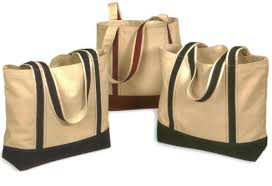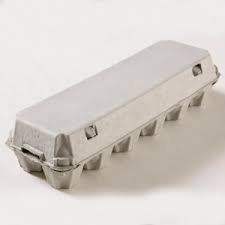This week, I want to hone in on the topic of eliminating the use of disposable bags and containers for your shopping. I will discuss solutions so you don't have to even worry about the paper vs. plastic dilemma.
Since having kids, but prior to my decision to strive for zero waste, I have been a conscious shopper in terms of what I bought. I am a "label reader." I am particular about what I am putting into and onto our bodies. It has been a priority for me to opt for all-natural products that don't contain artificial ingredients (like artificial colors, flavors and sweeteners),
preservatives or toxic ingredients (like parabens, phthalates, propylene glycol, petroleum bi-products, etc.) because of what I believe to be the harmful effects they cause. However, I never really thought about the issue of waste in what I chose to buy.
I used to think that "recycling" was the solution, and prided myself in it. Don't get me wrong, if the options are between something going in recycling or a land fill, that's a no-brainer. But, imagine if you didn't have to even make the choice because you never had the packaging to begin with? In addition to all of the resources it takes to make and distribute packaging, recycling requires its own slew of resources for collection, sorting, storage, shipping and repurposing of it. What's more is that some thing may only be able to be repurposed once (and hence will end up in a landfill after its second life). Finally, there are so many things that just simply can't be recycled. So part of my road to zero waste is also reducing the amount of recycling I generate
.
I am sure many may find the thought of bringing your own bags and containers to the store cumbersome, but I have actually found that this is not the case at all. In fact, I find it so fulfilling when I discover a new solution in this regard. I have the sense of accomplishment is the good I am doing and how it is getting me that much closer to "zero." The only hard part is making sure to remember your reusable bags and containers, but I will discuss some helpful tips on that below.
The first and most obvious change is B-Y-O-B, as in "bag," not booze or beer. The comment I hear most often from people with the best of intentions is, "I keep forgetting to bring them." I have made it a point to keep by bags and sometimes even extra storage containers in my car. I have never had a shortage of bags. Over the years we keep accumulating them, particularly from birthday parties and as freebies from seminars we have attended. One of my favorites is a cooler typy canvas bag that was a freebie my husband got at some seminar. It doubles as a cooler for bringing my meals to work (with me reusable sweat-free ice packs made from recycled plastic bottles).



While having bags in my car is never really an issue for me, making sure to have a particular type (bag, jar, bottle, storage container, etc.) or quantity of food storage items, is tougher. I recently came up with a tip that has proved extremely helpful. For a long time now, I have kept my grocery lists (one for each of the places I shop) on my smart phone. When I am home and realize we have or are about to run out of something, I stop what I am doing and add it to my digital list. Otherwise, I will likely forget to add it. I never have to worry about forgetting my list because I always have it with me.
But now, I have taken it one step further. Next to the items on my list, I make a notation if such item requires a particular type of reusable container that I need to bring with me. So, for example, if I am getting cheese or meat, I will put "(C)" next to it to stand for container. If I need a produce bag for something loose like bulk items or produce, I will denote with a "(B)". If I need a jar, I will put "(J)" next to it, and so on.
Another really helpful habit that I have recently adopted is to ask myself before I walk out the door, "Am I running any errands today?" If so, I look at my list, take a tally of each type storage item, and grab and put them in one of my shopping bags.
Since starting to do a lot of bulk bin shopping to avoid packaging, I have been faced with some challenges in terms of packaging. For example, I didn't know at first what to use for liquids, powders and spices, as produce bags, glass snap lock top containers and swing top jars didn't really work. In addition, I wasn't sure how you get the cashier to zero out the weight of the container itself so you are not over paying. But I have managed to work out most if not all of those problems as set forth below.
In most places where you can buy in bulk, before you start shopping, you can have one of the cashiers weigh your container and mark the "tare" on it. The tare is then deducted from the weight of the item (including the food) when you inevitably cash out at the end of shopping. For glass containers, I use a sharpee (as it actually will wash off of glass even though it doesn't wash out of fabric) or a grease pencil (BTW - the peels from the grease pencil are compostable). For my cloth bags, you can use a regular pencil, washable marker or washable crayon. To be honest, if the bag is super light, like my produce bags are, I don't even bother getting a tare for heaver items like nuts, grains, etc. In terms of the product number, I take a picture with my phone and rattle off the numbers to the cashier at checkout.
As I mentioned above, some items have proved trickier than others in terms of finding a packaging solution, but here's what I have come up with so far:
Mesh Bags: for produce and large bulk bin items that won't fall through holes like nuts, dried fruit, grains, dried legumes and granola (for which we go through a huge container every week):
Fine Textured Items: For things like flour, sugar, sea salt and protein powder, I have lined my above produce bags with leftover cotton fabric liners as seen below. But any sort of finely woven bag or liner will do. Alternatively, you can use a swing top jar like the one pictured below and just have the "tare" marked before filling it with the item.
Spices: I purchased plain spice bottles from specialtybottle.com. Each costs a dollar and comes with a shaker fitment like the one seen below. I recently cleaned out my spice rack to find spices that had been expired for years (some over 10 years YUCK)!! The great thing about buying your spices from bulk food stores is that you only buy what you need, so it doesn't go to waste by expiring. In fact, my jars are usually only about 1/3 full. I also use a sharpee or grease pencil to indicate the particular spice. These again require you getting the "tare" beforehand.
Liquids: For things like olive oil, agave, soy sauce and honey (all of which I can get from
http://www.rainbowacresca.com in Culver City), I purchased swing top bottles from specialtybottle.com for between $1.80 or $2.42 each.
Meet/Cheese: This is by far one of the easiest solutions because the meat/fish/cheese counters have the scales on hand. They simply weigh the container beforehand and then subtract such amount from the scale before adding the item I am buying. My containers of choice for such items are my glasslock containers because thy are leak proof and stack much easier than the swing top jars.
Milk/Yogurt/Juice/Soup: As mentioned in previous posts, I now buy all my milks, almond milk, juices and soups (unless I make homemade) in returnable glass jars from Whole Foods, Erewhon (which is 100% organic) or another specialty store. If you don't have a store like Erewhon that sells premade items in returnable bottles, another solution is making your own from scratch and putting in a reusable container. I used to do this for soups before discovering this convenient solution. Every once and a while, I will treat myself to one of Erewhon's organic iced coffees with Vanilla Almond Milk.
Farmers Market Tips: Try to buy as much as you can from farmers market, preferably organic stands. These will have traveled the least, which means they are fresher, last longer and take less resources to transport. This is my preferred place to shop and I buy and EVERYTHING packaging free. This is the only place I can find things for which stores do not have a container free solution, such as berries, eggs, cherry tomatoes. I have them put berries in a sturdy storage container so they don't get smooshed by my heavier items, cherry tomatoes in a produce bag (which you can also get from one of your local salad bars), bread/pastries in a produce bag and eggs in an empty carton that I just bring back every week. They then reuse the packaging that I opted not to use.


I must note that I still haven't found a solution for everything, but I am about 85-90% of the way there. Until I start making my own salty snacks, like crackers (which is one of the few processed foods we buy, but something my kids really, really love), and condiments, I won't be able to reach 100% zero waste shopping. For now, if you feel forced to choose a packaged item for whatever the reason, choose one whose packaging is almost certain to be recycled, like glass and aluminum and
AVOID PLASTIC. There are certain things for which I still haven't found a solution, like the various vinegars (red wine, cider, rice and white), which are essential for making my homemade salad dressings and pickling brine. Until I find one, I only buy these in glass jars and recycle them.
TIPS RECAP:
- Keep your grocery list on your smartphone so you have it at all times
- Mark a note next to an item that requires a particular type of reusable packaging you need to bring with you
- Keep bags and extra containers/produce bags in each vehicle
- Before you leave the house, ask yourself what errands you are running today, and check your list to make sure you have all your containers
This may seem daunting and a lot of work, but I PROMISE you it is not hard to make the switch. Within a couple of weeks, you will get the hang of it and it will become second nature.
If you are trying to find a packaging-free solution, do note hesitate to reach out to me. I would LOVE to help!!










